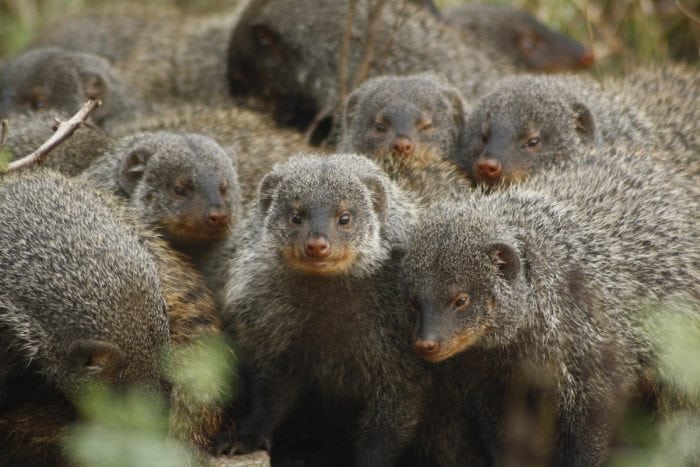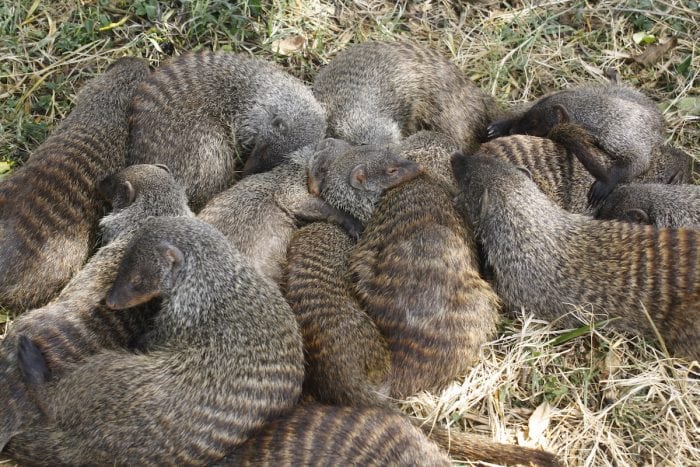
Family feuds, sibling squabbles, and rows with relatives. Sound familiar? We all know that families can be the source of great conflict as well as great cooperation.
In close-knit animal societies from ants to apes, conflict often arises over reproduction, social status, and resources. To maintain harmonious and stable relations within the group requires individuals to settle their differences. Usually, this can be achieved without having to break up the group, but in some species conflicts boil over to the point that some members are violently and permanently evicted. And in banded mongooses, a highly cooperative African mammal, ferocious battles to evict group members are common.
Banded mongooses live in large family groups of around 20 adults plus their offspring and exhibit cooperative care of young – meaning that group members help to raise pups that aren’t their own. But these groups of cuddly mongooses regularly erupt into civil war where multiple members are violently expelled and forced to leave. Evictions are triggered by competition over reproduction — females are evicted when there are lots of females trying to breed together, and males are evicted alongside them (in around half of cases) when there are lots of breeding males. Sometimes evictees are readmitted to their group, but in more than half of cases, the evicted individuals are permanently ejected. Mass evictions of up to 26 individuals have been observed, resulting in dramatic changes in the size of the evicting group.

Aggression Credit: Dave Seager
Eviction, when permanent, results in evictees dispersing from their social group and attempting to form a new group elsewhere. This can be a difficult and sometimes dangerous feat, particularly among banded mongooses where established groups are tightly packed into neighboring territories. Additionally, when male and female mongooses are evicted together, they split into same-sex cohorts and disperse separately. This means that dispersers have the added challenge of finding mates with whom to form a new group. These consequences of eviction are often not well studied because tracking dispersing groups is logistically challenging and the long-term fate of evicted individuals is often unknown.
At the Banded Mongoose Research Project, we have been continuously studying a population of banded mongooses in Uganda for the past 22 years. We can identify every individual in our population and have rich data on their lives – including whether they are evicted, and what happens to them after they leave their social group. This gives us the opportunity to study and understand their behavior in ways that would be impossible otherwise. We used our long-term data to investigate the consequences of eviction for individuals, groups, and the wider population.
We found that eviction had significant impacts on pup survival in evicting groups. Surprisingly, these violent evictions turned out to be good for pups – more pups survived when there was a permanent eviction from the group. In banded mongooses, most females in each group breed synchronously and give birth on exactly the same day, so competition for food and social care among their pups can be very high. By evicting reproductive competitors from the group, the females that remain reduce the level of competition for their pups and give them a better chance of surviving.
Eviction also affected the reproductive success of females that were exposed to an eviction. Evicted females gave birth to fewer surviving pups in the year following their expulsion than females that remained in the group. Life outside of the home group is hard, and the challenges of finding food, joining with new mates, and establishing a territory mean that evicted females suffer reduced reproductive success. Some evicted females did manage to successfully form new groups in the study area – either by usurping other females from an existing group, or by joining with a group of voluntarily dispersing males. However, eviction led to an increase in fighting between groups in the population, driven by frequent aggressive encounters between the evicting group and the evictees. Intergroup fighting in banded mongooses often leads to serious injury and death, so the effects of eviction for the evicting group can continue long after the eviction process itself.

Banded mongoose huddle Credit: Faye Thompson
Our results show that family feuds arise even in the most cooperative of animals, and sometimes can only be settled through the vicious expulsion of rival individuals. Eviction can have serious consequences for the individuals that are expelled, but also far-reaching, knock-on effects for other groups and the wider population. Whilst logistically challenging, long-term studies of social animals in the wild offer the best opportunity to study these effects to fully understand these unusual and fascinating behaviors.
These findings are described in the article entitled Individual and demographic consequences of mass eviction in cooperative banded mongooses, recently published in the journal Animal Behaviour. This work was conducted by Faye J. Thompson, Harry H. Marshall, Emma I.K. Vitikainen, Andrew J. Young, and Michael A. Cant from the University of Exeter.









